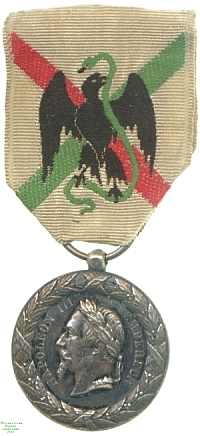
Obverse, a bust of Emperor Napoleon III wreathed and facing left, surrounded by a laurel wreath

Reverse, a bound wreath surrounding the inscription and a central inscription that reads "CUMBRES / CERRO BORREGO / SAN LORENZO / PUERLA / MEXICO"

Obverse, a bust of Emperor Napoleon III wreathed and facing left, surrounded by a laurel wreath |

Reverse, a bound wreath surrounding the inscription and a central inscription that reads "CUMBRES / CERRO BORREGO / SAN LORENZO / PUERLA / MEXICO" |
The young state of Mexico relied heavily on foreign loans, but in 1861 President Benito Juárez suspended interest payments on loans from France, Spain and Great Britain. All three powers united in action to recover their money. Ordinarily European operations on the American coast would have been internationally impossible, but the ongoing United States Civil War gave the European powers scope for direct intervention.
The power most interested in the campaign was France, whose developing intentions of conquest caused the British and Spanish to withdraw in April 1862. Initial Mexican resistance soon faltered before the efficiency of the French army and by June 1863 Mexico City had fallen, President Juárez fleeing north. The French installed a Habsburg Archduke, Maximilian, as head of a new liberal and constitutional monarchy, but he enjoyed little support. Resistance continued and by 1865 the military tide had begun to turn, as the re-United States began to supply the Mexican Republicans with arms. The French finally began to withdraw in 1866, leaving King Maximilian to defend himself; he was captured and executed in June 1867.
Early in the campaign, Emperor Napoléon III instituted a campaign award for its soldiers, and this continued to be issued until 1869 to veterans of the episode. The medal is distinguished by the elaborate design of the suspension ribbon, which shows an eagle fighting a snake.
This medal is unnamed, and it cannot now be known to whom it was awarded. Although the medal is part of the Watson Collection, Lester Watson's own lists give no provenance for it.